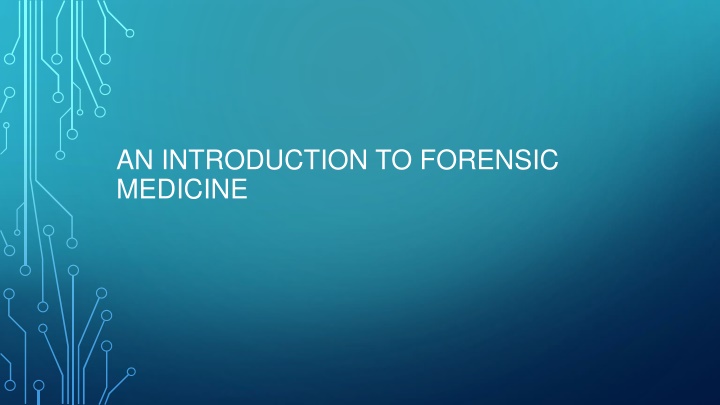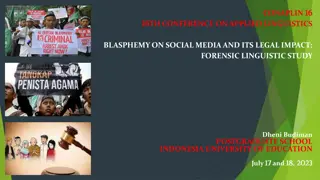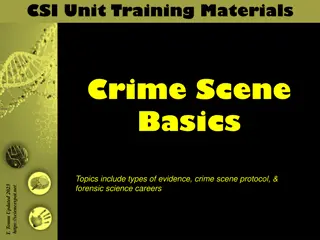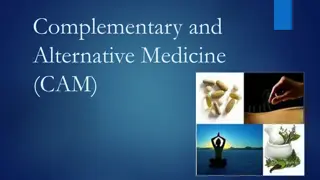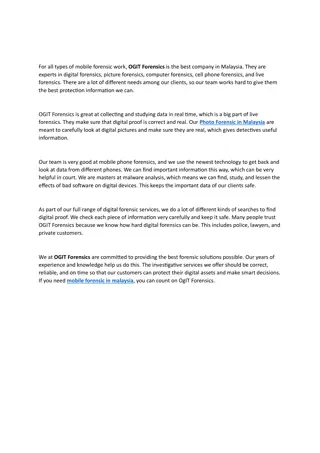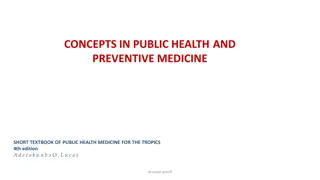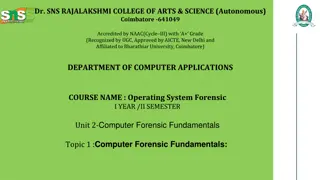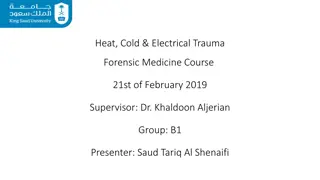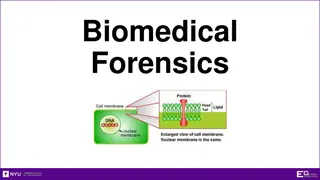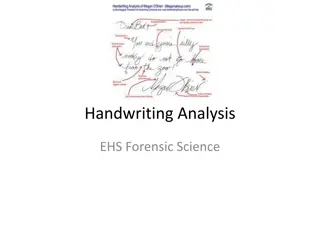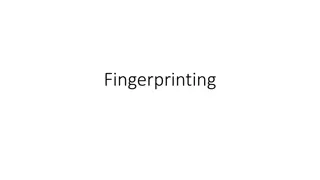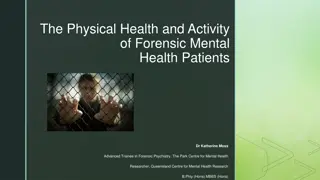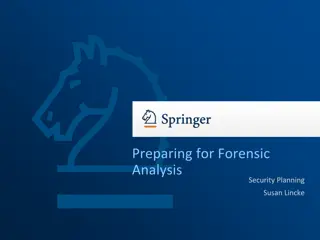AN INTRODUCTION TO FORENSIC MEDICINE
Forensic medicine is the science that applies medical principles to legal issues. Explore its fields, including forensic sciences, clinical forensic medicine, and the role of forensic pathologists. Learn about assessing fitness, conducting investigations, and identifying various injuries and causes of death in forensic cases.
Download Presentation

Please find below an Image/Link to download the presentation.
The content on the website is provided AS IS for your information and personal use only. It may not be sold, licensed, or shared on other websites without obtaining consent from the author.If you encounter any issues during the download, it is possible that the publisher has removed the file from their server.
You are allowed to download the files provided on this website for personal or commercial use, subject to the condition that they are used lawfully. All files are the property of their respective owners.
The content on the website is provided AS IS for your information and personal use only. It may not be sold, licensed, or shared on other websites without obtaining consent from the author.
E N D
Presentation Transcript
AN INTRODUCTION TO FORENSIC MEDICINE
A science that deals with the interaction of medical sciences with the law. the branch of medicine that applies the principles and information of medical sciences to legal problems within the field of law.
SOME FORENSIC FIELDS FORENSIC SCIENCES crime scene. criminal laboratory evidences . Serology . Forensic odontology. Forensic toxicology
CLINICAL FORENSIC MEDICINE A- Forensic physician I- Clinical Knowledge II- Basic Life Support Training III-Legal Knowledge in Statements / Reports/ Courts.
Fitness to be detained Fitness to be interviewed Mental Health Assessment Complaint alleged assault by Police Victim of Assault Drink-Driving Assessment Sexual assault victim
B-Forensic Pathologist Thanatology (death and PM changes). Sudden unexpected death Identification Wounds (types instrument )etc.. Head injuries
B-Forensic Pathologist continue Regional injuries ( chest limbs abdomen) Firearm injuries (characters weapons) Asphyxia (homicide suicide accidental) ML aspects of Pregnancy and abortion
B-Forensic Pathologist continue Death and injury in infancy Injury due to heat, cold and electricity Sexual offences
The body has already been identified and lawful consent obtained.
The pathologist first examines the outside of the body. The pathologist always examines the neck very carefully. Open the skull l, using a special vibrating saw. The top of the skull is removed, and the brain is cut free of its attachments.
Inspecting the brain often reveals surprises. A good pathologist takes some time to do this. The body is opened using a different types of incision. The incisions are carried down to the neck, the thoracic cage and the cavity of the abdomen
Examines the heart, and the first step following its removal is sectioning the coronary arteries.
DEFINITION OF DEATH Only organisms that have experienced life can die, as death represents the cessation of life in a previously living organism. Medically and scientifically, death is not an event; it is a process in which cellular metabolic processes in different tissues and organs cease to function at different rates. This differential rate of cellular death has resulted in much debate ethical, religious and moral as to when death actually coccurs . The practical solution to this argument is to consider the death of a single cell (cellular death) and the cessation of the integrated functioning of an individual (somatic death) as two separate aspects.
CELLULAR DEATH Cellular death means the cessation of respiration (the utilization of oxygen) and the normal metabolic activity in the body tissues and cells.
SOMATIC DEATH AND RESUSCITATION Somatic death means that the individual will never again communicate or deliberately interact with the environment.
Criteria for the diagnosis and confirmation of death following cardiorespiratory arrest Simultaneous and irreversible onset of apnoea and unconsciousness in the absence of the circulation, following full and extensive attempts at reversal of any contributing causes of cardiorespiratory arrest
One of the following applies: criteria for not attempting cardiopulmonary resuscitation (CPR) are fulfilled, or CPR attempts have failed, or life-sustaining treatment has been withdrawn, where a decision has been made that such treatment is not in the patient s best interest, or where there is an advance decision from the patient to refuse such treatment The person responsible for confirming death observes the individual for a minimum of 5 minutes, ensuring an absence of a central pulse on palpation and an absence of heart sounds on auscultation In a hospital setting, supplementary evidence of death may be provided in the form of asystole on a continuous electrocardiogram (ECG) display, absence of contractile activity using echocardiography or absence of pulsatile flow using direct intra-arterial pressure monitoring Confirmation of the absence of pupillary responses to light, of the corneal reflexes and any motor response to supra-orbital pressure The time of death is recorded when these criteria have been fulfi lled
